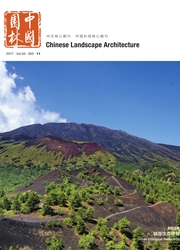

 中文摘要:
中文摘要:
城市热岛效应和气候暖化影响着园林植物的物候发生和景观季相,揭示和把握植物花期受变化气候作用的时空响应规律是风景园林应对气候变化的有效对策之一。通过对上海市公共绿地中的梅花(prunusmume)①、玉兰(Magnoliadenudata)和东京樱花(Cerasusyedoensis)3种早春开花植物的花期物候观测资料进行分析得出,早春时期上海城市热岛现象较为明显,热岛效应由城市核心区向周围近郊区辐射,作用半径约为20km,离城市核心区越远效应越低。东京樱花与城市热岛响应关系最高,依次是梅花和玉兰。在热岛效应作用下,中心城区植物花期比近郊区平均提前了2.2d,南部远郊滨海地区的植物花期推迟了一周左右。局地微气候对植物花期的调控有显著影响。在空间格局上,由城市核心区向城郊平均每推移10km,植物花期约推迟1d。
 英文摘要:
英文摘要:
The phenological characters and urban landscape are severely effected by Urban Heat Island(UHI)and climate warming.Revealing early spring flowering time response to climate change is one of the effective countermeasures of landscape planning.Shanghai UHI phenomenon is more obvious in the early spring period by temperature field measure,data analysis and early spring blossoms observations of plant phenology of prunus mume,Magnolia denudata and Cerasus yedoensis in urban green space.The UHI effect occurred in the urban core area radiates to the surrounding suburban area,and its radius covering about20km,the farther from the city center,the weaker effect works.The response relationship between M.denudata and UHI effect is highest,followed by A.mume and M.denudata.The flowering date in downtown is earlier than in the suburban area on average2.2d by the UHI effect.And the flowering of southern outer suburbs coastal areas delays by a week or so.The local microclimate has a significant impact on the regulation of flowering plants.In the spatial pattern,the flowering date delays about1d per10km from the downtown center to the suburbs.
 同期刊论文项目
同期刊论文项目
 同项目期刊论文
同项目期刊论文
 期刊信息
期刊信息
